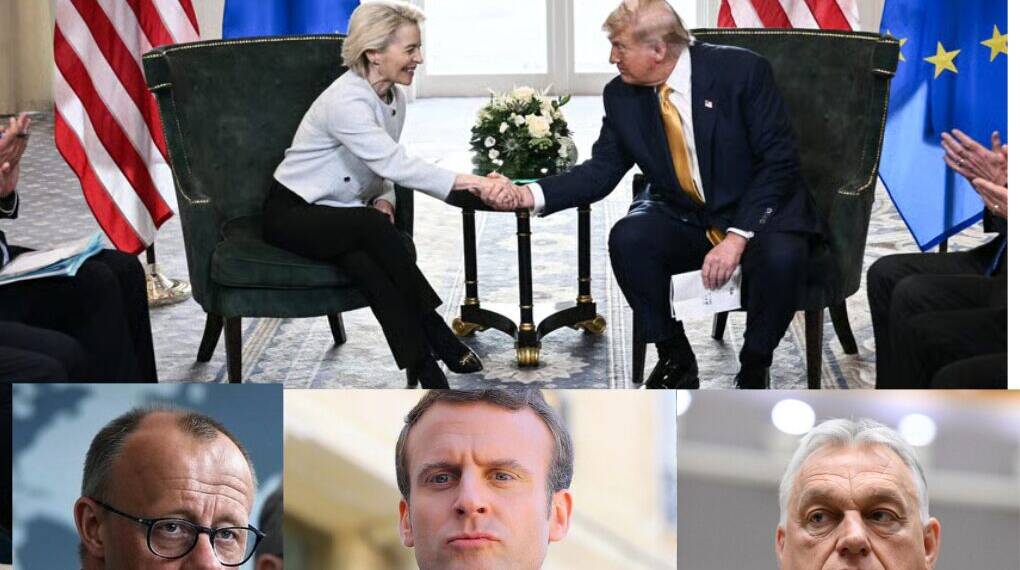The recently concluded trade agreement between the United States and the European Union has sparked strong, divergent reactions across Europe and beyond. While the deal, hailed by U.S. President Donald Trump as the “biggest ever,” averted the threat of a full-blown transatlantic trade war, critics argue it represents a strategic defeat for the EU.
A 15% blanket tariff on most EU goods, alongside massive commitments to U.S. energy and investments, has triggered backlash from European leaders and business groups, exposing deep fractures within the bloc.
Deal Overview: 15% Tariff in Exchange for Stability
Announced in Turnberry, Scotland, by President Trump and European Commission President Ursula von der Leyen, the agreement imposes a 15% tariff on most EU exports to the U.S. — a compromise from Trump’s initial 30% threat. The deal also includes:
$750 billion in EU purchases of U.S. natural gas, oil, and nuclear fuel to replace Russian energy.
$600 billion in EU investments into the American economy, with details on sources and allocation still undisclosed.
Exemptions for “strategic” goods: aircraft parts, select chemicals, some agricultural products, semiconductors, and critical raw materials.
However, issues like steel tariffs (remaining at 50%), pharmaceuticals, and alcoholic spirits remain unresolved.
Orban’s Rebuke: “Trump Outplayed the EU”
Hungarian Prime Minister Viktor Orban was among the first to slam the deal, likening Trump to a “heavyweight” negotiator while portraying von der Leyen as a “featherweight.” He derided the 15% tariff as economically damaging, especially when compared to the UK’s earlier bilateral agreement with the U.S., which featured more favorable terms.
In a pointed podcast interview, Orban described the pact as a sign of Europe’s declining geopolitical leverage.
French Fury: “A Dark Day for Europe”
French Prime Minister François Bayrou led a chorus of condemnation, calling the agreement an act of “submission” to American pressure. French Trade Minister Laurent Saint-Martin accused Brussels of failing to wield adequate retaliatory tools, and warned that “Trump only understands force.”
Calls have grown within France to activate the EU’s Anti-Coercion Instrument, which could restrict U.S. access to public procurement and financial markets unless better terms are renegotiated.
Bayrou lamented, “It is a dark day when an alliance of free peoples resigns itself to submission.” President Macron’s silence has added to speculation about internal discord within the French government.
German and Italian Reactions: Acceptance Over Confrontation
German Chancellor Friedrich Merz acknowledged the economic toll but welcomed the deal’s role in avoiding a deeper conflict. Merz admitted it was an “asymmetrical agreement” but emphasized that “under the current conditions, it was impossible to achieve anything better.”
Italy’s Giorgia Meloni similarly praised the agreement for restoring trade predictability, a view consistent with the interests of both countries’ export-heavy economies.
Ireland: “Least Bad Option”
Ireland, the EU’s most U.S.-dependent economy, has taken a more measured stance. Minister of State Neale Richmond described the deal as far from ideal but preferable to a 30% tariff scenario. Irish Taoiseach Micheál Martin welcomed the “stability” the deal offers, though he acknowledged the increased cost burden for exporters.
Industry Impact: From Cars to Pharmaceuticals
The European automotive sector, long a target of Trump’s tariffs, will see some relief: the new 15% rate replaces a previous 27.5% burden. However, leading firms like Volkswagen and Mercedes-Benz warn of profit hits and future price hikes.
Pharmaceuticals — a key industry in countries like Ireland and Germany — were left out of the main agreement. Discussions are ongoing, as both sides try to avoid disruptions in medicine supply chains.
Steel remains another flashpoint, with Trump maintaining a punitive 50% tariff. Von der Leyen indicated future talks might transition the tariff to a quota-based system, though no timeline has been set.
Market and Economic Outlook
Markets reacted with guarded optimism. The euro rose 0.2% following the announcement, reflecting relief that a deeper trade war was avoided. Still, economists like Carsten Brzeski (ING) urged caution, noting that “nothing is on paper yet,” and warning of the deal’s inflationary consequences.
The European Commission downgraded its 2025 growth forecast from 1.3% to 0.9% earlier this year, partly in anticipation of higher trade frictions. Industry groups across Europe warn that the 15% tariff will reduce competitiveness and profit margins, with companies either passing costs to American consumers or absorbing them internally.
Strategic Consequences: EU’s Unity in Question
The trade agreement has revealed sharp differences within the EU. While France and Hungary see capitulation, Germany and Italy favor compromise. Ireland and smaller economies are treading cautiously, seeking predictability above all else.
Meanwhile, Trump has framed the deal as a win in his “90 deals in 90 days” campaign, aligning it with other recent pacts with the UK, Japan, Indonesia, and Vietnam. His administration claims the deal will open vast markets for U.S. agriculture, energy, and manufacturing.
But in Europe, questions abound: Has the EU lost its strategic edge in global trade? Did von der Leyen go too far to avert a trade war? Can Brussels renegotiate the remaining gaps before more damage is done?
Fragile Victory or Strategic Setback?
While the U.S.-EU trade deal averts an immediate economic crisis, it has sparked intense political and public debate across the continent. Some see it as a necessary evil to ensure economic stability; others view it as a sign of European weakness in the face of aggressive U.S. protectionism.
With key sectors left unresolved and political tensions rising, this is not a final chapter — but the beginning of a complex and contentious new era in transatlantic trade.








